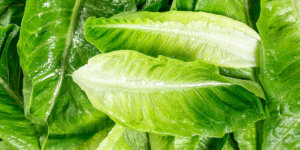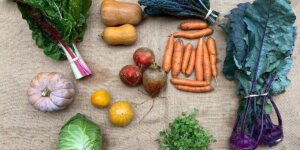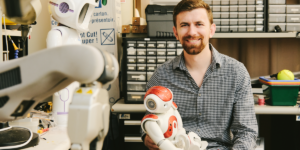
A customized book of recipes created by Quick!Help for recipients of produce from foodbanks has been tested and seems to lead to better nutrition
A Eureka moment has led to an alliance between USC computer scientists and nutrition experts that promises better meals for the 24 million Americans who depend on community pantries.
Eduard Hovy and Andrew Philpot of the USC Information Sciences Institute have partnered with Susan Evans and Peter Clarke, directors of the highly-honored “Wholesalers to the Hungry” program, to create an instant, individualized menu and recipe planner to help low-income seniors and families who use the fresh produce their program supplies to church and charitable group pantries and local food projects around the nation.The same technology may at some point appear in supermarkets, producing an instantly printed set of recipes tailored to the food a customer has just purchased.
For the existing system, information about recipients – their cooking skills (beginner? advanced?), available kitchen utensils (steamer? microwave?), household composition (kids? seniors?), food preferences (garlic?) and much more – is quickly entered into a system by volunteers while recipients are waiting in line.
By the time the recipients have gone through the line and picked up their food, a detailed document is waiting for each of them with illustrated recipes tailored to their specific, individual needs, in English or Spanish.
In preliminary tests, the system, called “Quick! Help for Meals” has shown dramatic results in boosting pantry clients’ use of fresh produce, “a critical element in improving their nutrition,” according to Evans, a research scientist at the USC Keck School of Medicine Institute for Prevention Research.
“Hundreds of studies show that fresh produce in the diet helps people avoid or reduce obesity, which is linked to heart disease, diabetes and many other illnesses, early death, and increased costs of health care,” adds Clarke, director of the Center for Health & Medical Communication at USC’s Annenberg School for Communication.
“Fewer than one out of four persons on average currently meets the recommended minimum five servings per day of fruits and vegetables. Low-income people score even lower,” he continued.
“The stores where they must shop do not carry much produce, and price it expensively when they do. Many of the working poor have little time available for cooking and often have not learned culinary skills at a parent’s knee. They lead stressful lives. Only well-designed and individualized recipes and nutrition tips will help break a dependence on convenience foods that are high in fats, salt, and sugar.”

In the field Research assistant Sonya Woolsey collects information that will be used to prepare the customized Quick!Help brochure that a pantry client will receive along with food.
Supported by ISI, the National Science Foundation, and Kraft Foods, “Quick! Help for Meals” will receive further testing in summer and fall. If results on immediate consumption of fresh produce continue to be as positive as they have been, field trials will expand to learn whether “Quick! Help” improves long-term dietary habits in households that receive the service.
More than 7,000 community pantries nationwide could eventually become outlets for teaching people how to prepare simple and tasty meals from scratch, according to Clarke.
“Quick! Help” grows directly out of Evans and Clarke’s 12-year experience with the problems of getting fresh produce into the hands of needy Americans.
The team has worked with charitable groups all across the country to create 140 programs that collect unsold fresh fruits and vegetables from wholesalers and other sources, and send them to frontline charitable organizations. Last year, these programs distributed more than 280 million pounds of fresh produce.
Their work has won them the U.S. Department of Agriculture’s “Heroes of Hunger” honor and other awards. But in recent years, Evans said, “we started looking closely at the fresh produce distribution, we did surveys of recipients, and we found some problems.
“We discovered that many food pantry clients didn’t accept fresh produce when freely available, or didn’t know how to prepare it, or didn’t know how to store it.”
At first, the team thought that the answer was simply to prepare a brochure, or a few different brochures, to give out with the food.
“But the problem is, one size doesn’t fit all,” Evans explained. Different recipients have wildly different needs. Seniors, she explained, wouldn’t throw out food, but often have limited cooking facilities. Many young families, raised on fast food, have almost no cooking skills. Preferences for recipes varied according to ethnicity and many other characteristics.
In focus sessions with food bank recipients, Clarke said “velcro experiments” were used to let the recipients show what information was useful, by sticking pieces containing words and pictures on a board, and discarding unwanted ideas and suggestions.
“What we immediately realized was the results varied hugely from one recipient to another. Even people alike in age and household size expressed different information needs.”
And, said Evans, just preparing a big catchall compendium – or even several different editions – didn’t work either. “What we found was if people didn’t find what they needed immediately, they assumed it wasn’t there and tossed the flyer away.”
Compounding the problem, charitable food pantries themselves got only a few hours notice about which fresh foods would be available that day. And if all they get that day is broccoli, or carrots, suitable recipes would have to be found. “We needed to invent an information tool that would adapt immediately to ever-changing supplies of food,” said Evans.
The bottom line: not one or two different types of flyers, but flyers that could be individually produced, on the spot, to whatever needs and interests the food recipients expressed.
“We knew what type of information product we needed, but we didn’t know how to do it,” said Evans. “Then we attended a presentation by Eduard Hovy.”
Hovy, an expert on computer-based language translation, text summarization, and web search, was one of a number of scientists presenting talks in 2000 to Keck School faculty on activities at ISI, part of the USC Viterbi School of Engineering’s Information Sciences located in Marina del Rey. Hovy described computer software that could produce customized output on a variety of topics, tailored to the information need, the situation, and the reader.
“We looked at each other and said, ‘Eureka!!’ Evans recalled. The team sat down with Hovy, and began to explore various designs, with research associate Andrew Philpot working on the programming.
Within six months Philpot produced a draft version of “Quick! Help,” which has has been tested and refined as resources have been found to support the effort.
“Even though the technology is tried and true,” said Philpot, “the engineering requirements were tougher in a sense — a system which works great when I demo it in the lab takes lots of loving care to work reliably for a coordinator in the field.” Quick! Help’s layout involves not just text but graphics, and includes a number of features and recognizes the low literacy of many users:
&bull A customized cover, with the name of the recipient, and an illustration of choice such as a snapshot of the recipient and his or her children, or a religious figure.
&bull Pictures of finished servings or key steps in preparation. Recipes also highlight useful hints about whether items are good as leftovers, can be frozen, may be made in advance, are “kid friendly,” and more.
Clarke and Evans are pleased with the early results testing the system’s effectiveness. For example, a recent study included three groups of recipients, all of whom received free produce. One group (control group) received no information about food preparation; one group (generic group) received an uncustomized version of all recipes in the Quick! Help database. The final group (tailored group) got the individualized Quick! Help flyer.
“In interviews five days after receiving food, recipients of the individually-tailored version of Quick! Help said that they had not only used a recipe, but had used many or all the recipes, one after another. A much larger percentage (90 percent, versus 60 percent) read the customized flyer than read the generic one.
Twice as many recipients of customized flyers were able to recall a recipe from it. Individualized versions of Quick!Help motivated household cooks to try different preparations, important for stimulating people’s interests in a food, and to use the perishable foods quickly, before they could spoil.
We found no differences in use of fresh produce between the control and the generic groups,” said Clarke, “suggesting that giving typical flyers and giving nothing lead to the same results.”
“We called our food recipients again – six weeks after they had gotten flyers,” said Evans. “We didn’t expect this, but we found that many of them still had and were still using the individualized Quick! Help material printed out for them. Households given the generic Quick! Help had discarded it.”
The Quick! Help technology is fairly simple at heart, says Hovy. The most complex step in building a tailorable menu is developing the models of the possible readers, and associating each text fragment with just the appropriate reader characteristics. Once this has been done, the software can stitch together hundreds or even thousands of variants of the basic documents.
This technology, which was first developed by Hovy and colleagues at the Universities of Toronto and Waterloo in Canada, has been patented, and is the basis of a small company in Canada, which sold one version of the system to a company supporting people who stop smoking.
“Just as for Quick! Help recipes, individualized daily or weekly letters to encourage people to stick with their non-smoking regimens are significantly more effective than generic one-size-fits-all reminders,” says Hovy.
“It would be elementary to extend Quick! Help to allow people at supermarkets to request individualized recipes while they wait in checkout lines. In fact, this technology is the logical next step, from broadcast to narrowcast to individualized pointcasting of information. You might one day receive ads that were made exactly and specifically for you, created by a Quick! Help system of the future,” Hovy adds.

A recipe for change One item in a Quick!Help customized recipe book.
The USC Office of the Provost, which encourages interdisciplinary work, recently rewarded this project with a stipend for an undergraduate research assistant.
“What we are exploring now,” said Evans, “is the possibility that, if we can offer a broad enough range of customized choices, can we help people change their diets, in a healthier direction.”
Much remains to be done. “This summer, in July 2004, we are rolling out the tablet PC-based system, with the capability to take digital pictures of the client (or their children) and insert them into the output brochure,” said Philpot.
“We also need fast, high quality print capability — lasers are too fragile and expensive, inkjets too slow. We’d like to have wireless communication between the tablets and the printers. We also need to add many more food items, and another area of work will be extension to additional languages – Mandarin Chinese, Russian, Armenian, and Tagalog, and whatever other languages are useful in the deployment neighborhoods.”
But Philpot is glad to have a chance to work on the problems. “Underlying it all, the idea that technology can make a real difference in the lives of food pantry clients continues to serve as a strong motivation for involvement,” he said.
Published on June 18th, 2004
Last updated on August 9th, 2021












